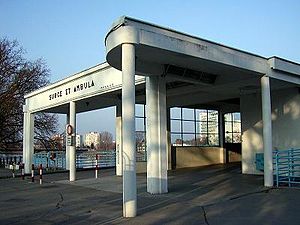Czechoslovak architect
Emil Belluš (19 September 1899 – 14 December 1979) was a Slovak functionalist architect.[1]
Career
Emil Belluš began his studies at the Technical University in Budapest in 1918, but completed them at the Czech Technical University in Prague in 1923. He then returned to Slovakia where he became a founding member of the Association of Slovak Artists (later the Slovak Architects Society, of which he was president from 1945 to 1953) and of the Slovak Rowing Club. He designed the clubhouse for the rowing club.[2]
While working in an international functionalist style, he was willing to modify it with classical elements, as can be seen in the Colonnade Bridge at Piešťany completed in 1932.[3]
His design for the head office of the Slovak National Bank (1938) showed the influence of Italian Rationalism.[4]
The annual architectural award of the Slovak Architects Society is named the Emil Belluš Prize in his memory.
Buildings
Works on Belluš
- Martin Kusý, Emil Belluš. Bratislava: Tatran, 1984.
- Emil Belluš: Architektonické dielo, exhibition catalogue. Bratislava: Slovak National Gallery, 1989.
- Architekt Emil Belluš, regionálna moderna, exhibition catalogue. Bratislava: Spolok architektov Slovenska (Slovak Architects Society), 1992.
References
- ^ James Stevens Curl, "Belluš, Emil", Oxford Dictionary of Architecture and Landscape Architecture (Oxford University Press, 2000). Retrieved January 19, 2015 from Encyclopedia.com: http://www.encyclopedia.com/doc/1O1-BelluEmil.html
- ^ Anthony Alofsin, When Buildings Speak (University of Chicago Press, 2006), p. 236.
- ^ Anthony Alofsin, When Buildings Speak (University of Chicago Press, 2006), pp. 237–8.
- ^ Henrieta Moravčíková, "Bratislava", in Capital Cities in the Aftermath of Empires: Planning in Central and Southeastern Europe, edited by Emily Gunzburger Makas and Tanja Damljanovic Conley (Routledge, 2009), p. 184.
|
|---|
| International | |
|---|
| National | |
|---|
| Artists | |
|---|
| People | |
|---|
| Other | |
|---|



